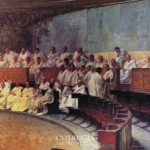
Are YOU Awake or Asleep?
22/11/2023
Elite Members of Roman Society
29/11/2023
Banking in Ancient Rome
The ancient Romans, heavily influenced by Greek civilization, quickly adopted the concept of banking, which originally came from the Near East.
Like the Greeks, the Romans initially tied banking to religious temples, such as the Temple of Artemis in Ephesus and the Temple of Castor and Pollux in Rome. Over time, Roman bankers took on many of the same roles seen in Greece: they accepted deposits, issued loans, maintained customer accounts, and managed assets. Courts accepted their records as valid proof in legal disputes.
However, the Romans, known for their administrative skill, refined these banking practices and formalized the institutions. Their improvements made banking more efficient and competitive. Thanks to these advancements, people could transfer large sums across provinces without physically moving coins.
Two key groups dominated financial activities in ancient Rome: elite members of society and professional money dealers.





